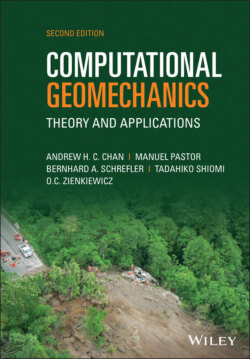Читать книгу Computational Geomechanics - Manuel Pastor - Страница 43
3.2.4.2 Splitting or Partitioned Solution Procedures
ОглавлениеThe most common way of solving the coupled system of equations is the monolithic scheme where both the coupled equations are solved simultaneously at each time step as discussed above. However, also splitting solutions are possible where the two (or three) equations are solved separately at each time step. To conserve the coupled nature of the problem, iterations within each time step are necessary even in the linear case. The reason for applying partitioned solutions may be the fact that solvers for the solid and fluid fields are already at hand so that only the interaction has to be taken into account. This type of solution procedure is extensively investigated for the dynamic case by Markert et al. (2010) and, as already mentioned, by Park and Felippa (1983), Park (1983), and Zienkiewicz et al. (1988). A splitting procedure will be used in Section 5.5 both for the dynamic case and consolidation allowing for same interpolation for both u and p. Partitioned solutions are quite common in consolidation and have been extensively treated in Lewis and Schrefler (1998). From the investigation of the iteration convergence within a time step, Turska and Schrefler (1993) found the existence of a lower limit for Δt/h2 which means that it is not always possible to decrease Δt without also decreasing the mesh size h. Such a limit was also found by Murthy et al. (1989) for Poisson‐type equations and by Rank et al. (1983) for transient finite element analyses by invoking the discrete maximum principle.
